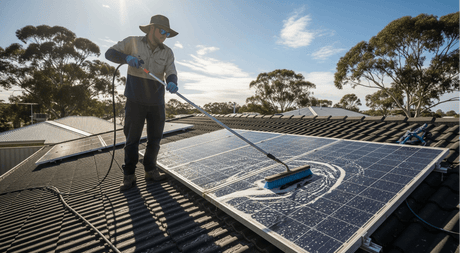Are you tired of high electricity costs or concerned about your carbon footprint?
You're not alone. A growing number of Australians have grown weary of paying hefty electricity bills and are switching to a cheaper and more renewable energy option: solar power Net Metering.
In 2020, analysis from Australia's national science agency, CSIRO, found that solar panel installations were up nearly 30% from 2019. Every day, Australians are tackling rising living costs by installing more rooftop solar panels than ever before or increasing the size of their rooftop solar arrays.
Australians are one of the world leaders in solar power adoption - and with good reason. Solar panels allow everyday families to reduce their household bills and reduce their carbon footprint. The thought of going off-grid and relying entirely on solar power isn't for everyone, but with Net Metering, you can have the best of both worlds.
Net Metering makes switching to solar power even more appealing, as it allows you to stay connected to the utility grid while also reducing your energy bills.
Read on to learn more about how Net Metering works in Australia and how it may benefit your household.
What is Solar Net Metering?
Solar Net Metering is a system that allows everyday households and businesses to use both solar power and stay connected to a traditional electrical grid. Net Metering refers to the billing mechanism that electrical utility providers use to credit people who use a solar panel system. The owners of solar panels can connect their system to the grid and provide solar power for other users, for which they will get credits.
Many different countries around the world use Net Metering to various degrees. Usually, customers will be paid for their solar energy at a rate that is close to what you pay for grid energy. In Australia, the surplus energy generated from your solar panels will be credited at the retail electricity price. Therefore, you will only pay for the difference in usage between your net energy consumption and surplus solar power production.
When installing a Net Metering system, remember that the energy absorbed into panels is first sent to your household. Then, the excess energy that isn't required or isn't being utilized is sent back to the grid.
Types of Solar Net Metering Agreements
Solar Energy in Australia includes two different meters: Solar Net Metering and Gross Net Metering.
- Net Metering is the measurement that is used when solar power is consumed in your own house, and only the unused or excess solar electricity gets exported into the grid.
- Gross Metering exports all the solar electricity generated into the grid. There is usually plenty of solar energy available in sunny Australia, especially if you have large solar arrays that can generate more solar power.
For both Net Metering and Gross Metering, you need solar panels, also known as solar arrays, that can produce a significant amount of electricity.
How Does Net Metering Work in Australia?
For Net Metering, the electricity used in your household will primarily be generated from the sun, meaning the sun is the primary source of power to your television units, air conditioning, microwave, and so on.
Any excess gets fed back into the utility grid. However, if the weather is poor or you don't get enough solar energy to meet your consumption, you can subsidize with grid power. The grid will provide stored energy back to meet your current electrical needs.
Excess power will be stored in your grid for future purposes. So you don't waste solar electricity, nor are you piling up your tariff; a feed-in surcharge will only get applied to the amount that your household consumes, not the energy sent back to the grid. It's a cost-effective and eco-friendly solution.
The exchange of energy will be balanced and reflected on your energy bills. To estimate how much energy you could produce and how much you will use, refer to our solar panel calculator.
What is the Net Meter?
The Net Meter is actually the device that measures your household's electrical consumption. It displays how much energy you may consume and produce. It also aids in measuring all the excess solar generation that your home may require in the future.
With Net Metering, the meter runs forward, and you are charged only for the deficit. Depending on your Net Meter system type, the solar power system will either send the energy to the grid regularly, e.g., every 30 minutes or at the end of each day.
It's important to note that DIY solar installations are often not eligible for Net Metering or other feed-in tariffs in Australia. To take advantage of Net Metering, you'll need your solar panels to be professionally installed and connected to the grid. So although a DIY solar panel installation may be tempting to save money up-front, you could lose money long term.
Different types of Solar Net Metering Agreements:
Australian Net Metering Metering falls into three categories:
- Virtual Net Metering: This is a system where solar energy can be enjoyed without worrying about installing solar panels: energy in this system is utilized from a solar panel site when transferring and supporting your household's energy needs.
- Aggregate Net Metering: In this system, one household using solar energy can help support and power another home or apartment.
- Remote Net Metering: A system made for farms and non-residential customers to help them gather as much credit resulting in a reduced electricity bill.
How Does Gross Metering Work in Australia?
Gross Metering is less common in Australia, but is widely used in countries like Germany and Italy. Two states in Australia, New South Wales (NSW) and Canberra (CBR) use Gross Metering.
Gross Metering is in some ways more transparent than Net Metering. Your monthly or quarterly electricity bill will tell you exactly how much electricity your solar panel system generated. There's no ambiguity, unlike the Net Metering approach.
Gross Metering will also record the entire amount of electricity your home consumes. The enhanced awareness of energy use and consumption can help you adjust or reduce your energy usage habits and make your home more energy-efficient.
Benefits of Net Metering
Net Metering has many benefits to both individual homeowners and the environment. Here are some of the benefits you can expect from installing a grid-tied solar panel system.
Reduced energy bills
Cost-savings are one of the biggest draw cards of switching to solar power. If you live in a sunny area, you're likely to see a significant decrease in your energy costs. If you produce enough solar power to cover your own energy consumption, you may even earn money from Net Metering. You'll only pay for electricity when you can't cover your own energy needs. And, you can get credited for any excess solar energy you contribute to the grid!
Power more than one building
Solar panels and solar panel kits can be used on your homes, cabin, garages, sheds, and even vehicles. Everyone can benefit from using solar power, whether you have an urban home or multiple buildings on a rural farm property.
Reduce your carbon footprint
Switching to solar power makes a big difference to your carbon footprint. You can contribute to saving our precious natural resources by becoming more self-sufficient. Solar power is far more eco-friendly than traditional electric or gas-powered generators, and often makes you more aware of unnecessary energy usage.
Does My State Offer Net Metering?
Solar energy is becoming more popular across Australia, but incentives and Net Metering differ across states. Not everywhere in Australia will be eligible for Net Metering. The below states or cities do offer Net Metering.
- Adelaide
- Alice Springs
- Blacktown
- Central Victoria
- Moreland
- Perth
- Townsville
Net Metering may also be referred to as a feed-in tariff. These feed-in tariffs or refunds may be offered at the discretion of different energy utility providers. Therefore, the availability of feed-in-tariffs differs across the country by state and energy retailers. These tariffs work as a type of Net Metering to give you money back against your energy bill if you send your excess solar power back to the electricity grid.
Switching to solar power
Now that you have a clear idea of how solar Net Metering works in Australia, you can assess whether switching to solar power is the right move for your household.
Australia has some of the world's best conditions for solar power. There is abundant sunshine year-round, which makes solar panels productive in all seasons. There are also some local, state, and federal government solar incentives that encourage Australians to make the switch.
Solar power not only reduces your monthly energy costs, but the initial installation costs may be less than you think. In addition to Net Metering, some Australian states offer other financial incentives to partially cover set-up costs.
There are many cost savings associated with switching to solar. But remember, switching to solar power can benefit everyone, not just your wallet. Solar is renewable energy the saves so many resources. You and your family can power up all the devices and appliances you need at home, knowing you've reduced your carbon footprint.
So why not contribute to positive change and make the switch to solar panels with Renogy.







![What Is a DC to DC Battery Charger [Comprehensive Guide]](http://au.renogy.com/cdn/shop/articles/IMG_3829_bd86de74-31d6-49fd-b9d5-265bb723091d.jpg?v=1757582605&width=460)


